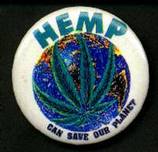 |
HEMP ENVIRONMENTAL BENEFITS LETTERS ROOM USA Hemp Museum Store - Bookmark This Site - Museum Link - Email The Museum |
| HEMP ENVIRONMENTAL BENEFITS ROOM GUIDE 12. LETTERS ON THE ENVIRONMENT. |
 |
Other rooms in the museum contain letters that relate to hemp and the environment, from saving topsoil in the agriculture room to replacing cotton as a fabric in the textile room. Learn about all aspects of hemp and the environment. |
*****
|
LETTER SUBMITTED TO THE LOS ANGELES TIMES February 12, 2003 RE: Logging in the National Forests Ten years ago I showed the Hemp Museum to the owner of the largest privately owned logging company in California. He agreed that we need to grow hemp in California. When our National Forests are all that is left for the tens of thousands of uses that wood pulp provides, why not switch to hemp. Forests are the lungs of the earth. The more we cut down the less oxygen is produced. Hemp grows four times faster than trees over the same time period. Hemp produces wood and four times as much oxygen as the trees we left standing. Keep that up and we would reverse global warming. Richard M. Davis, Curator, U.S.A. Hemp Museum |
*****
|
COMMENTARY SUBMITTED TO THE LA WEEKLY: MAY 31, 2002. RE: Global Warming, Energy & Hemp: A Time for Understanding Energy.
Adversity brings opportunity. The power crisis in California, was
a sure sign we need change in the way we look at energy. We
are set to travel to northern tip of Alaska to suck out the last
remaining drops of our domestic supply of fossil oil, while we grow ever
more vulnerable to disruptions from suppliers around the world.
Now we have more warnings from the National Academy of Sciences on
abrupt changes in global warming. It is time to break that cycle.
It will not happen unless we all learn more about energy and global
warming. Not a lot, just the basics.
Right now California has 31 biomass
electrical generating plants that were not operating during this state’s
energy crisis for lack of biomass fuel (now mostly logging wastes).
This fuel could be grown by California’s farmers. Fuel that helps
reverse the greenhouse effect. And hemp is best at growing biomass.
U.S. Dept. Of Agriculture Bulletin 404, 1916, says hemp produces four times
more biomass than trees over time. “Rather than as a crisis, the energy problem can be viewed as a challenge and opportunity. Fossil fuels will be exhausted at a given time dependency upon fossil fuels has led to the extreme economic and political vulnerability of our nation. Because fossil fuels are finite, we must examine the question of future energy sources.” The federal government has controlled the farming of hemp in the face of a Supreme Court ruling U.S. v. Butler, 1936, that states: “From the accepted doctrine that the United States is a government of delegated powers, it follows that those not expressly granted, or reasonably to be implied from as such are conferred, are reserved to the states or to the people. To forestall any suggestion to the contrary, the Tenth Amendment was adopted. The same proposition, otherwise stated, is that powers not granted are prohibited. None to regulate agricultural production is given, and therefore legislation by Congress for that purpose is forbidden.”
California and its people have a
Constitutional right to pursue alternative energy using hemp.
Will it take another 18 years before some leader has the courage to lead the
way? Will we wait for an abrupt warming trend? California
legislature? Governor Davis? Richard M. Davis, Curator, U.S.A. Hemp Museum ***** |
| LETTER SUBMITTED TO THE LOS ANGELES
TIMES: JULY 15, 2001.
RE: Global Warming & Yankee Ingenuity. (L.A. Times: July 15, 2001) Let’s get this right. We ship carbon from halfway around the world at a tremendous economic and environmental cost for energy and then we want to bury it in the only ocean system on the planet. Ray Weiss of Scripps Institute is right, "The 500-pound gorilla is the burning of fossil fuels (oil, coal, natural gas)." Hemp is the best Yankee ingenuity we have to deal with the problem of carbon dioxide. Hemp breathes carbon dioxide and converts it to plant material (fiber and wood) four times faster than trees. This we have known since USDA Bulletin 404, 1918, was published. Due to the prohibition of hemp growing the Energy Department cannot even mention hemp. And burning plant material is not the same as burning fossil fuel as implied by the article. Yes if we convert hemp to alcohol for fuel we end up with carbon dioxide in the atmosphere, but the next year we grow the same amount of hemp and the same amount of carbon dioxide is absorbed back into the plant. After the first year no further loading to the atmosphere occurs for this same amount. In our example, the amount of hemp burned for fuel replaces fossil fuels which are the 500-pound gorilla. Another way hemp acts as a carbon sink is through the replacement of forest wood for paper and building materials such as press board and laminated beams. Hemp converted to fuel oil could fill our strategic energy reserves, as foreign crude oil does at present, with the exception that the money stays here at home in the farmers pocket, to be spent in our country. The carbon sink then becomes houses, schools, hospitals, and books. The forests remain to absorb more carbon dioxide. The forests of Europe are gone, and hemp is once again being grown in Europe for paper, press board and many other products. England, Canada, France, Italy, Holland, Russia, China are among the countries growing hemp. The ocean is not a test tube we need to mess with more than we presently do. Hemp was brought back during World War II on an emergency basis and almost 400,000 acres were planted in two years. The fate of our planet seems emergency enough to bring back hemp immediately. Richard M. Davis, Curator, U. S. A. Hemp Museum |
*****
| LETTER SUBMITTED TO THE LOS ANGELES
TIMES: MARCH 30, 1998. RE: Commentary: "Save the Forests, Not each tree." Patrick Moore, founder of Greenspirit, ought to be ashamed of himself for his misleading and inaccurate article. This type of article makes me wonder who funds Greenspirit. Mr. Moore says the battle for America’s forests was fought 100 years ago, but failed to state the fact that sustainable forestry does not exist today and has not existed for the past 100 years. U.S. Dept. of Agricultural Bulletin 404, 1916, warned of the pressure on our forests from paper production alone. And we now have four times the population of 100 years ago. Mr. Moore makes this speech on trees and wood: "But now, it is so trendy to be opposed to cutting trees that many people find it possible to ignore the absolute necessity of using wood in their everyday lives. Many seem willing to forget that wood is, without question, the most renewable and environmentally friendly of all materials used to build our civilization. Wood is the material embodiment of solar energy, created by photosynthesis in a factory called the forest, and whether we like it or not, wood can only be obtained from trees." This speech is misleading and its conclusion false. Mr. Moore should read Bulletin 404. It clearly states that four times as much wood can be obtained from a woody herbaceous shrub called hemp than from any tree. And I’m sitting here looking at a sample of medium density fiberboard from hemp that is stronger than that from trees and typing on a computer that could be made from hemp plastic. Hemp fuels could replace fossil fuels. And hemp can be grown on a "factory" called the family farm. Forests are not factories, they are ecosystems, full of natural relationships of life that are destroyed by logging. Wood may be a necessity of everyday life, but so are living trees. And leaving trees in the forest and using hemp and other plant sources for wood is the way to reverse the greenhouse gas buildup, because all plants absorb CO2 and give off oxygen. Now you know, Mr. Moore, which wood (hemp) is,
without question, the most renewable and environmentally friendly, which wood
(hemp) is the embodiment of solar energy, whether we like it or not. For years
we have tried to get the major environmental groups to acknowledge and work for
hemp -Greenpeace, the Sierra Club. Now you know, Mr. Moore. Now
Greenspirit knows. What are you going to do about it? The farmers
would love to hear what it is. ***** |
| LETTER SUBMITTED TO THE LOS ANGELES TIMES
EDITOR RE: SUCCESS IS IN THE AIR. PART 1. L.A. TIMES, NOV. 3,1997. Go figure says the advertisement, cleanest air in 50 years. Fact says the ad, California still suffers from the worst pollution problem in the United States. Cannabis hemp, now being grown in Canada but illegal for California farmers, is earth’s premier annual crop for biomass fuels such as ethanol, methanol or bio-diesel (seed oil and alcohol blend). The refusal of our leaders to face the facts of hemp for industrial uses such as clean air fuels has condemned us to decades of smog in Los Angeles, the most polluted city in the country. According to literature I got from the California Energy Commission years ago, alcohol fuel could reduce ground level ozone 90 percent without exhaust controls. Biomass fuels are also the way to reverse global warming which has been in the news so much recently. Fossil fuels are one cause. Growing green plants recycles these gasses, releasing much needed oxygen. Free the plant and clean the air. Anyone listening? Richard M. Davis, Curator, USA Hemp Museum ***** |
HEMP ENVIRONMENTAL BENEFITS ROOM GUIDE
USA Hemp Museum Store - Bookmark This Site - Museum Link - Email The Museum